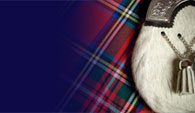Seann Triubhas
History: This dance is considered to be the classic dance of all the Highland Solos and is said to be the expression of the national grief at the banning of the kilt following the last battle at Culloden which ended the rebellion in support of Bonnie Prince Charlie. It was decreed that the Trews, the Sassenach garb, must be worn and this ban was not repleaded till 1782, over 40 years later. The name Seann Triubhas (old trews) was chosen in scorn of the Trews and movements such as Flourish and Trouser Shake are said to indicate the desire of the Highlander to kick off the Trews. The lively and buoyant steps of the Quick Time may well portray freedom and delight in the return of the kilt. It is interesting to note the use of the French term Pas de Basque in Seann Triubhas and it is possible that this reflects the influence from Bonnie Charles' association with the French Court.Interpretation: The Seann Triubhas is a slow, smooth, graceful and artistic dance showing character and dignity conveying the contrasts between the suppressed spirit of the people and their protest at having to wear the Trews, the Sassenach Garb.
The sharp, clean cut, buoyant movements of the Quick Time enable the dancer to portray the ease of movement and express the freedom and delight at again wearing the kilt.
Execution: Much of the beauty of the dance is brought about by the dancer displaying sustained controlled movements in a flowing style with breadth of movement giving a softer, lighter quality in the Slow Time. The Quick Time is executed on one spot using Strathspey type steps.
Pattern: The dance commences in Slow time with a circular step followed by steps performed traveling sideways, forward, back and in a diagonal direction giving the dancer a chance to interpret "poetry in motion"


